| |
Ten Honored by the Institute for Distinguished Contributions to Architecture
Summary: The
AIA has selected four individuals and six groups as recipients of
the 2007 Institute Honors for Collaborative Achievement. The award,
to be presented in May at the AIA National Convention in San Antonio,
recognizes and encourages distinguished achievements of allied professionals,
clients, organizations, architect teams, knowledge communities, and
others who have had a beneficial influence on or advanced the architecture
profession.
The recipients of 2007 Institute Honors for Collaborative Achievement are:
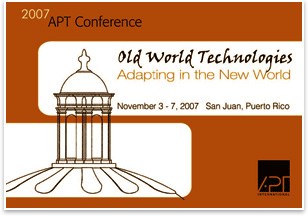 The Association for Preservation Technology International (APT), founded in 1968, promotes multidisciplinary technology for conserving historic structures and their settings. The efforts of its Technical Committee on Sustainable Preservation “illustrates that a small committee can have an unparalleled impact on national and international organizations,” write James R. McDonald, AIA, for the AIA Historic Resources Committee, and James Binkley, FAIA, for the AIA Committee on the Environment in their joint letter of nomination. The nominators note the APT’s commitment to “proactive measures to integrate preservation values and sustainable objectives into well designed preservation projects … Sustainability being an important stated objective of the [AIA], it seems most appropriate that this collaborative effort be recognized.” The APT has worked closely with the AIA and government agencies since its founding and, more recently, with certification groups such as the U.S. Green Building Council and Green Globe. The Association for Preservation Technology International (APT), founded in 1968, promotes multidisciplinary technology for conserving historic structures and their settings. The efforts of its Technical Committee on Sustainable Preservation “illustrates that a small committee can have an unparalleled impact on national and international organizations,” write James R. McDonald, AIA, for the AIA Historic Resources Committee, and James Binkley, FAIA, for the AIA Committee on the Environment in their joint letter of nomination. The nominators note the APT’s commitment to “proactive measures to integrate preservation values and sustainable objectives into well designed preservation projects … Sustainability being an important stated objective of the [AIA], it seems most appropriate that this collaborative effort be recognized.” The APT has worked closely with the AIA and government agencies since its founding and, more recently, with certification groups such as the U.S. Green Building Council and Green Globe.
 Bryan Bell, founder in 1991 of Design Corps, brings his earlier experience at the office of Steven Holl and as Rural Studio project director with AIA Gold Medalist Samuel Mockbee to bring architecture services to all segments of society. He has worked with migrant farm workers, low-income families, and young designers interested in the social application of architecture. “Bell has been exceptionally effective in applying the highest standards of design … carried out through nonprofit organization,” writes John Morris Dixon, FAIA, on behalf of the AIA Committee on Design nomination of Bell for “his powerful linkage of architecture and social consciousness.” In a letter of support, Associate Professor Stephen A. Goldsmith, of the University of Utah, writes: “For those of us out here in the field working to heal and repair our places, Bryan’s charisma, charm, and humility informs a design sensibility that places people first.” Bryan Bell, founder in 1991 of Design Corps, brings his earlier experience at the office of Steven Holl and as Rural Studio project director with AIA Gold Medalist Samuel Mockbee to bring architecture services to all segments of society. He has worked with migrant farm workers, low-income families, and young designers interested in the social application of architecture. “Bell has been exceptionally effective in applying the highest standards of design … carried out through nonprofit organization,” writes John Morris Dixon, FAIA, on behalf of the AIA Committee on Design nomination of Bell for “his powerful linkage of architecture and social consciousness.” In a letter of support, Associate Professor Stephen A. Goldsmith, of the University of Utah, writes: “For those of us out here in the field working to heal and repair our places, Bryan’s charisma, charm, and humility informs a design sensibility that places people first.”
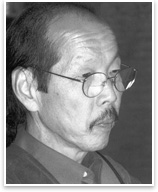 Francis D.K. Ching is widely recognized for his “extraordinary series of books—11 to date—explaining the principles of architecture and architecture drawing in a manner that is accessible and informative,” writes John Morris Dixon, FAIA, in the AIA Committee on Design nomination letter. His books, many of which are widely adopted by schools of design in the U.S. and abroad, have been translated into 16 languages ranging from Indonesian and Chinese to Thai and Turkish. With the total sales of his books estimated at 2 million, Ching’s accomplishments are exceptional “in communicating the basics of architecture to those entering the profession—and those who might be encouraged to enter it,” Dixon writes. Although retired from active teaching this past year, Ching continues his legacy of innovation in his published work. He is currently preparing the third edition of Architecture: Form, Space and Order, in which he is incorporating a series of animations to supplement the hard copy. Francis D.K. Ching is widely recognized for his “extraordinary series of books—11 to date—explaining the principles of architecture and architecture drawing in a manner that is accessible and informative,” writes John Morris Dixon, FAIA, in the AIA Committee on Design nomination letter. His books, many of which are widely adopted by schools of design in the U.S. and abroad, have been translated into 16 languages ranging from Indonesian and Chinese to Thai and Turkish. With the total sales of his books estimated at 2 million, Ching’s accomplishments are exceptional “in communicating the basics of architecture to those entering the profession—and those who might be encouraged to enter it,” Dixon writes. Although retired from active teaching this past year, Ching continues his legacy of innovation in his published work. He is currently preparing the third edition of Architecture: Form, Space and Order, in which he is incorporating a series of animations to supplement the hard copy.
 The Directory of African American Architects, established in 1991 by two faculty of the University of Cincinnati, Bradford Grant and Daniel Mann, garners an Institute Honor for Collaborative Achievement for its success in advancing “the visibility, representation, and contributions of African-American architects,” in the words of its founding collaborators. The directory lists more than 1,500 African-American architects who practice in the private and public sectors, teach in higher education, or work outside the profession and still maintain licensure. The listing, with its series of highlight studies, continues to expand and now includes a Web site and a comparable listing of landscape architects. Noting the directory’s immediate usefulness, J. Max Bond Jr., FAIA, writes in support of the nomination: “The Directory’s existence helped give a presence to African-American architects. It helped people contact each other and thus helped to reinforce the creation of a community of Architects.” The Directory of African American Architects, established in 1991 by two faculty of the University of Cincinnati, Bradford Grant and Daniel Mann, garners an Institute Honor for Collaborative Achievement for its success in advancing “the visibility, representation, and contributions of African-American architects,” in the words of its founding collaborators. The directory lists more than 1,500 African-American architects who practice in the private and public sectors, teach in higher education, or work outside the profession and still maintain licensure. The listing, with its series of highlight studies, continues to expand and now includes a Web site and a comparable listing of landscape architects. Noting the directory’s immediate usefulness, J. Max Bond Jr., FAIA, writes in support of the nomination: “The Directory’s existence helped give a presence to African-American architects. It helped people contact each other and thus helped to reinforce the creation of a community of Architects.”
 The U.S. General Services Administration Office of the Chief Architect is responsible for the development and administration of the GSA Design Excellence Program, now in its second decade. In that time, the office has collaborated with architects of the highest caliber “to design and construct an extraordinary portfolio of public buildings, contemporary landmarks that are enriching communities across the nation,” writes Jane Weinzapfel, FAIA, as president of the Boston Society of Architects, the nominator. The work of the Office of the Chief Architect deserves recognition both for this portfolio and “for the influence it has on other public agencies and on private-sector clients, stimulating them to enrich their own design efforts,” she writes. Success in reshaping American cities and towns—from economic renewal to exemplifying the value of sustainable, livable, cost-conscious design—has been both goal and result of the office from its 1999 pilot-project John Joseph Moakley U.S. Courthouse in Boston by Henry N. Cobb, FAIA, to the present day. (Pictured is the Point Roberts, Wash., U.S. Port of Entry, a 2000 GSA Design Award recipient by Miller Hull Partnership. Photo © James F. Housel.) The U.S. General Services Administration Office of the Chief Architect is responsible for the development and administration of the GSA Design Excellence Program, now in its second decade. In that time, the office has collaborated with architects of the highest caliber “to design and construct an extraordinary portfolio of public buildings, contemporary landmarks that are enriching communities across the nation,” writes Jane Weinzapfel, FAIA, as president of the Boston Society of Architects, the nominator. The work of the Office of the Chief Architect deserves recognition both for this portfolio and “for the influence it has on other public agencies and on private-sector clients, stimulating them to enrich their own design efforts,” she writes. Success in reshaping American cities and towns—from economic renewal to exemplifying the value of sustainable, livable, cost-conscious design—has been both goal and result of the office from its 1999 pilot-project John Joseph Moakley U.S. Courthouse in Boston by Henry N. Cobb, FAIA, to the present day. (Pictured is the Point Roberts, Wash., U.S. Port of Entry, a 2000 GSA Design Award recipient by Miller Hull Partnership. Photo © James F. Housel.)
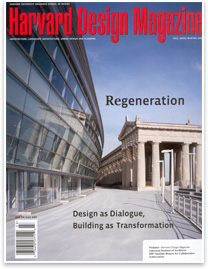 Harvard
Design magazine, published
three times per year for the last decade, focuses on issues of
great import to architecture, landscape architecture, and urban
design. Under the stewardship of Editor William S. Saunders, HSD’s
assistant dean, the magazine publishes substantive book reviews
and regular columns of design, places, ideas, culture, education,
and practice. With a circulation of 14,000, the magazine is distributed
free to aumni, sold in bookstores and on newsstands internationally,
and sent to 700 subscribers. The magazine has published essays
from lead thinkers in the profession, who include, to name a few,
Stan Allen, Peter Blake, Denise Scott Brown, Peter Calthorpe, Robert
Campbell, Henry Cobb, Thomas Fisher, Kenneth Frampton, Paul Goldberger,
Zaha Hadid, Charles Jencks, Rem Koolhaas, Rafael Moneo, I.M. Pei,
Philippe Starck, and Robert Venturi. Harvard
Design magazine, published
three times per year for the last decade, focuses on issues of
great import to architecture, landscape architecture, and urban
design. Under the stewardship of Editor William S. Saunders, HSD’s
assistant dean, the magazine publishes substantive book reviews
and regular columns of design, places, ideas, culture, education,
and practice. With a circulation of 14,000, the magazine is distributed
free to aumni, sold in bookstores and on newsstands internationally,
and sent to 700 subscribers. The magazine has published essays
from lead thinkers in the profession, who include, to name a few,
Stan Allen, Peter Blake, Denise Scott Brown, Peter Calthorpe, Robert
Campbell, Henry Cobb, Thomas Fisher, Kenneth Frampton, Paul Goldberger,
Zaha Hadid, Charles Jencks, Rem Koolhaas, Rafael Moneo, I.M. Pei,
Philippe Starck, and Robert Venturi.
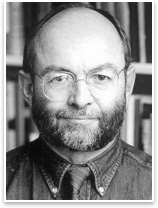 Thomas S. Hines, writer and architecture critic, “has produced some of America’s most illuminating studies of the lives and works of architects—Daniel Burnham, Irving Gill, and Richard Neutra—in relation to their cultural worlds,” writes John Morris Dixon, FAIA, in his letter of nomination. A native of Oxford, Miss., he also is writer and photographer for William Faulkner and the Tangible Past: The Architecture of Yoknapatawpha, which examines the architecture of Oxford (Faulkner’s model for his fictional county) and Faulkner’s use of architecture in his writing. In addition to his books, Hines’ writings have appeared in Architectural Record, Architecture, Architectural Digest, Progressive Architecture, and many other publications. Also active in academia, after serving as a professor of architecture history for the University of California Los Angeles’s History Department and Department of Architecture and Urban Design for 30 years, Hines retired last year and now serves as professor emeritus. Thomas S. Hines, writer and architecture critic, “has produced some of America’s most illuminating studies of the lives and works of architects—Daniel Burnham, Irving Gill, and Richard Neutra—in relation to their cultural worlds,” writes John Morris Dixon, FAIA, in his letter of nomination. A native of Oxford, Miss., he also is writer and photographer for William Faulkner and the Tangible Past: The Architecture of Yoknapatawpha, which examines the architecture of Oxford (Faulkner’s model for his fictional county) and Faulkner’s use of architecture in his writing. In addition to his books, Hines’ writings have appeared in Architectural Record, Architecture, Architectural Digest, Progressive Architecture, and many other publications. Also active in academia, after serving as a professor of architecture history for the University of California Los Angeles’s History Department and Department of Architecture and Urban Design for 30 years, Hines retired last year and now serves as professor emeritus.
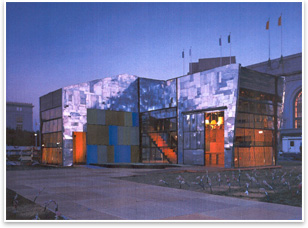 Public Architecture, San Francisco, puts the resources of architecture in the service of the public interest by identifying and solving problems of human interaction in the built environment and acting as a new model of architecture practice. Founded and chaired by John Peterson, AIA, Public Architecture runs the 1% Solution Program, supported by a grant from the National Endowment for the Arts. The goal of the program is to direct 1 percent of all architects’ working hours—pro bono—to matters of public interest. “Through its collaborative and highly innovative projects and programs, Public Architecture’s every effort is distinguished by attention to design,” writes Jane Weinzapfel, FAIA (principal of Leers Weinapfel, this year’s 2007 Firm Award winner), in her letter of support. “It is recognition such as the Institute Honors for Collaborative Achievement that will help Public Architecture attract precisely the kind of institutional support that it will need to succeed in the long term … and its success will be our success as design professionals.” (Pictured is ScrapHouse, a temporary demonstration home built in six weeks in San Francisco. Courtesy of Public Architecture.) Public Architecture, San Francisco, puts the resources of architecture in the service of the public interest by identifying and solving problems of human interaction in the built environment and acting as a new model of architecture practice. Founded and chaired by John Peterson, AIA, Public Architecture runs the 1% Solution Program, supported by a grant from the National Endowment for the Arts. The goal of the program is to direct 1 percent of all architects’ working hours—pro bono—to matters of public interest. “Through its collaborative and highly innovative projects and programs, Public Architecture’s every effort is distinguished by attention to design,” writes Jane Weinzapfel, FAIA (principal of Leers Weinapfel, this year’s 2007 Firm Award winner), in her letter of support. “It is recognition such as the Institute Honors for Collaborative Achievement that will help Public Architecture attract precisely the kind of institutional support that it will need to succeed in the long term … and its success will be our success as design professionals.” (Pictured is ScrapHouse, a temporary demonstration home built in six weeks in San Francisco. Courtesy of Public Architecture.)
 Rocky
Mountain Institute, an independent, nonpartisan, entrepreneurial,
nonprofit “think-and-do” tank, creates abundance by
design through fulfilling its mission of “fostering the efficient
and restorative use of resources to make the world secure, just,
prosperous, and life-sustaining.” Founded in 1982 in Snowmass
and Boulder, Colo., by Amory and Hunter Lovins, RMI’s staff
of 55 today includes three architects, four engineers, and many
more people trained in various design professions. Research activities
incorporate three areas: built environment, energy and resources,
and breakthrough design. Among RMI’s myriad contributions
to the architecture profession are the seminal 1990-1997 Pacific
Gas and Electric Company ACT2 study, which demonstrated the large
energy savings with little cost investment in new and retrofit
buildings; cofounding of the U.S. Green Building Council; assessment
for the greening of the White House; and helping to assess green
building opportunities in tsunami-ravaged South Asia, flooded New
Orleans, and the rustbelt of Ohio’s Cuyahoga Valley. (Pictured
is RMI headquarters in Snowmass. Photo courtesy of RMI.) Rocky
Mountain Institute, an independent, nonpartisan, entrepreneurial,
nonprofit “think-and-do” tank, creates abundance by
design through fulfilling its mission of “fostering the efficient
and restorative use of resources to make the world secure, just,
prosperous, and life-sustaining.” Founded in 1982 in Snowmass
and Boulder, Colo., by Amory and Hunter Lovins, RMI’s staff
of 55 today includes three architects, four engineers, and many
more people trained in various design professions. Research activities
incorporate three areas: built environment, energy and resources,
and breakthrough design. Among RMI’s myriad contributions
to the architecture profession are the seminal 1990-1997 Pacific
Gas and Electric Company ACT2 study, which demonstrated the large
energy savings with little cost investment in new and retrofit
buildings; cofounding of the U.S. Green Building Council; assessment
for the greening of the White House; and helping to assess green
building opportunities in tsunami-ravaged South Asia, flooded New
Orleans, and the rustbelt of Ohio’s Cuyahoga Valley. (Pictured
is RMI headquarters in Snowmass. Photo courtesy of RMI.)
 Witold Rybczynski, Hon. FAIA—architect, author, and educator—received the eighth Vincent J. Scully Prize on January 17. Best known for his work as an architecture critic and essayist, Rybczynski has been described as “one of the most original, accessible, and stimulating writers on architecture” by Library Journal. He is the author of numerous acclaimed books enjoyed by architects and the general public alike, including: Home (1986), which has been translated into 10 languages; The Most Beautiful House in the World (1989); and The Look of Architecture (2000). Rybczynski contributes regularly on architecture and urbanism to the New York Review of Books, Atlantic, and The New Yorker and is an architecture critic for the on-line magazine Slate. He currently is the University of Pennsylvania School of Design’s Meyerson Professor of Urbanism and serves on the U.S. Commission of Fine Arts. “In the last 20 years, through his writings and talks, Witold Rybczynski has been a uniquely brilliant beacon for architecture in the public mind in North America,” writes nominator Michael Mense, FAIA. (Photo © David Graham.) Witold Rybczynski, Hon. FAIA—architect, author, and educator—received the eighth Vincent J. Scully Prize on January 17. Best known for his work as an architecture critic and essayist, Rybczynski has been described as “one of the most original, accessible, and stimulating writers on architecture” by Library Journal. He is the author of numerous acclaimed books enjoyed by architects and the general public alike, including: Home (1986), which has been translated into 10 languages; The Most Beautiful House in the World (1989); and The Look of Architecture (2000). Rybczynski contributes regularly on architecture and urbanism to the New York Review of Books, Atlantic, and The New Yorker and is an architecture critic for the on-line magazine Slate. He currently is the University of Pennsylvania School of Design’s Meyerson Professor of Urbanism and serves on the U.S. Commission of Fine Arts. “In the last 20 years, through his writings and talks, Witold Rybczynski has been a uniquely brilliant beacon for architecture in the public mind in North America,” writes nominator Michael Mense, FAIA. (Photo © David Graham.)
|
|


 The Association for Preservation Technology International (APT),
The Association for Preservation Technology International (APT), Bryan Bell,
Bryan Bell, Francis D.K. Ching
Francis D.K. Ching The
The  The U.S. General Services Administration Office of the Chief Architect
The U.S. General Services Administration Office of the Chief Architect Harvard
Design
Harvard
Design Thomas S. Hines, writer and architecture critic,
Thomas S. Hines, writer and architecture critic, Public Architecture,
Public Architecture, Rocky
Mountain Institute,
Rocky
Mountain Institute, Witold Rybczynski, Hon. FAIA
Witold Rybczynski, Hon. FAIA